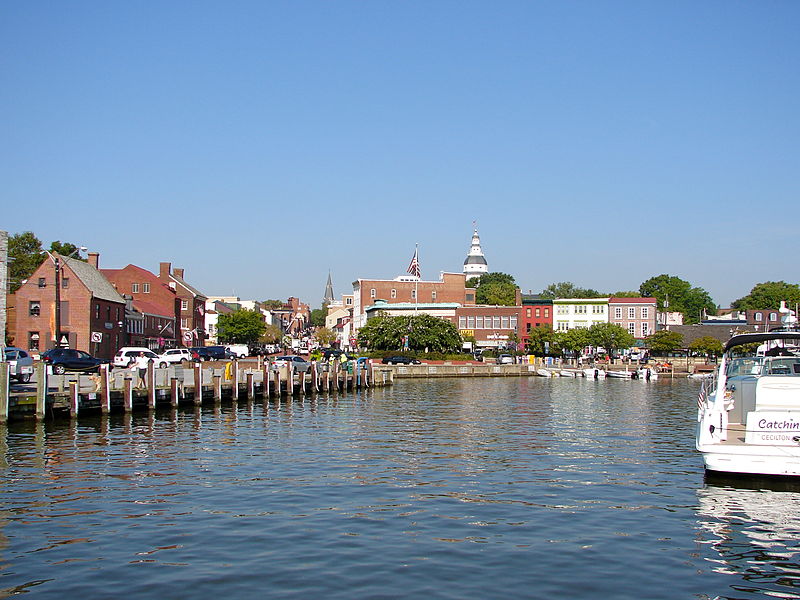ANNAPOLIS AND NAVIGABILITY
Part 2
 |
| Annapolis |
We wanted to illustrate the size of vessels we ere talking about and needed a picture in the public domain. This one was described as an official USN Photo. Some times we are both cheap and expedient, but we are always cheap.
|
A visitor can actually see a portion of the broad Chesapeake Bay from the city dock and occasionally may see large container ships, tankers, and bulk carriers either plying through or awaiting a Baltimore berth in "Annapolis Anchorage". The anchorage bearing the town's name provides no direct revenues and no readily observable commercial opportunities to the "port that it is located a stone's throw from. So in the waters that we might term the "observable harbor" the tourist sees mostly yachts but also an occasional small naval craft, passing small tug or off in the distance a large merchant ship. Unlike that other southern capital that we recently examined, Montgomery, Alabama; Annapolis was never in danger of being rendered or declared "non navigable". The city had little to do with what seemed like a "natural transition" from an ocean cargo port , to a commercial fishing port, to a mixed use small craft port, to one of the World's pen ultimate yacht havens.The city did not fight its loss of status as a port of entry for large seagoing ships , or the loss of the commercial fishing fleet. The city did "cooperate with the apparently inevitable and helped in the development of the yacht haven, even maintaining a harbor master service. But the only commercial vessels operating in the harbor are two day excursion boats and a couple of excursion sail boats.
The city recently successfully converted an old building that once housed an element of the State's "fish cops" into the National Sailing Museum. But there are other buildings of historical interest that were created for commercial maritime enterprise that are persistently vacant or subject to serial commercial failure. Next to the famed Naval hangout, The Fleet Reserve Club there existed for many decades a marine hardware store. The store evolved in the era of commercial fishing and survived well into the era of yacht dominance, but could not survive the evolution of the recreational boating equivalent of the "Big Box Stores". While many of the old marine rigging shops, hard ware stores, outfitter buildings have now been converted into successful restaurants, the city fathers want to maintain the "maritime character" of the area. Unfortunately for the property owner of the once prosperous boat hardware distributor site the building isn't large enough to attract a big box operator in marine hardware .
With the nearby heavy commercial ship traffic now being administered as an interrelated part of the port of Baltimore the Customs inspectors, most of the Coast Guard boarding officers and agricultural inspectors, or classification society marine surveyors, or other marine surveyors use launch services out of Baltimore when they have to visit ships in Annapolis Anchorage. The former retail space now too small to re-assume the role of marine hardware store is cut off from use as a launch service office, marine surveyors office (unless a company specializing in yachts), or federal maritime police or regulatory agency office. Annapolis can see the ocean traffic but lets it pass by without a thought to its potential as a revenue source for the city or even as an addition to the tourist interest in the town.
When the ocean ships of the day became too large to call at the old colonial city dock sites, Annapolis wrote off deep sea, deep draft commerce though it was only a rifle shot from deep water. Promoted correctly Annapolis Anchorage even though now irretrievably in the hands of Baltimore could still be tapped as a source of new business opportunities by the city of Annapolis.When we next get a chance to examine this issue we'll look at how some other former ports prospered as "gateways" and providers of ":lay berths". A port's development should never be considered "final". Things change over time, commercial navigability is never something that a city should be willing to give up. Annapolis, now in the top tier of towns vying for the title "Sailing Capital of the United States" still thinks of itself as a naval or maritime town and so it is, but it did not have to give up on commercial navigation. It still doesn't have to.
Why is it that some towns like Houston will go to great lengths to artificially create navigability, where there was none, and others blessed with natural navigability will wax and wain over the exploitation or improvement of navigability. Where a town is navigable, no effort should be spared to improve and expand navigability.
to be continued.......

ON LINE FISHING EQUIPMENT SHOP
No comments:
Post a Comment